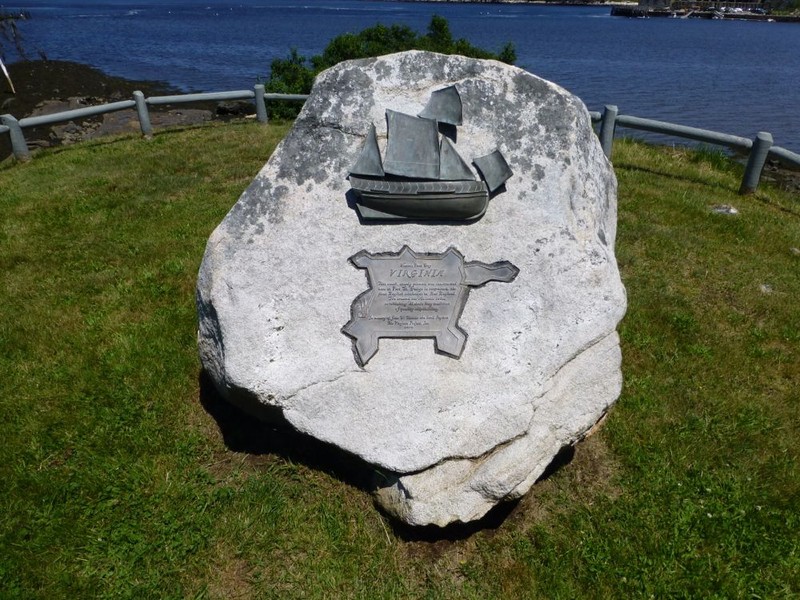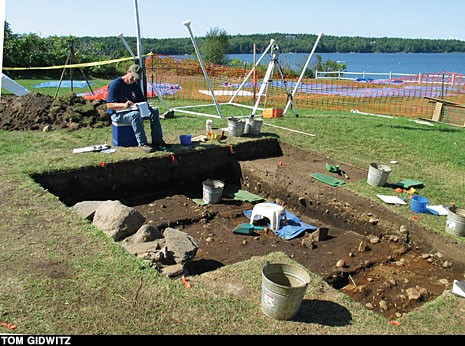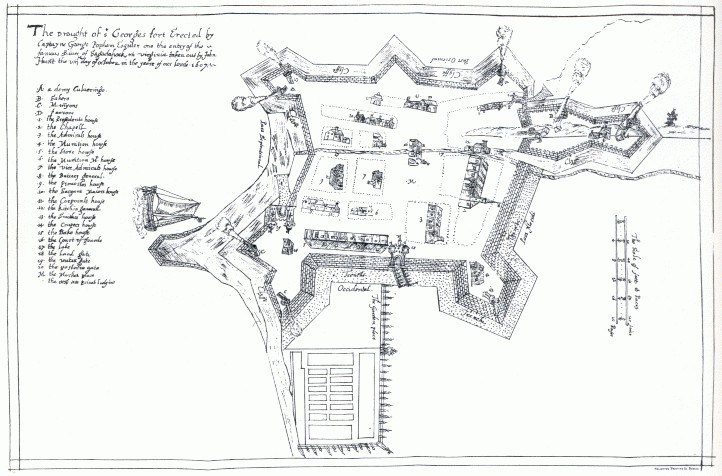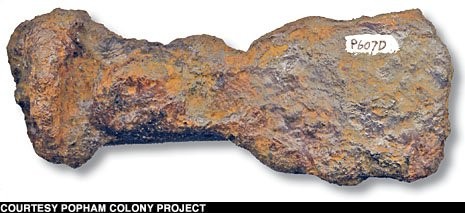Popham Colony- Maine's Lost Colony
Introduction
Text-to-speech Audio
Images
This rock, located on the outskirts of Popham Beach, in Phippsburg, Maine, commemorates the Virginia of Sagadahoc, the first British vessel built in North America.

This photo shows the excavation of Popham Colony by Jeffrey Brain, in which many artifacts, including documents and building supplies, were discovered.

This map of Popham Colony was drawn by colonist John Hunt, showing the details and organization of the colony.

This is a badly corroded iron caulking tool that was discovered during one of the excavations led by Jeffrey Brain. He speculated that it was used to build the Virginia of Sagadahoc.

Backstory and Context
Text-to-speech Audio
In 1606. British King James I granted the Virginia Company a charter to establish settlements in America. Two competing sections of the Virginia Company, the Plymouth Company and the London Company, set out to be the first to establish a colony in the New World. While the London Company was tasked to colonize the southern section of the New World, The Plymouth Company was given the area that is now New England, with Lord Chief Justice of England, Sir John Popham, funding the colony, and his relative, George Popham, leading the colony. To promote the competitiveness between the two companies, the middle ground between the south and New England could be claimed by whichever colony proved most successful. The London Company landed in America in May of 1607 and formed Jamestown, while the Plymouth Company set sail in May, landing on the coast of Maine in August.
The 120 sailors, soldiers, carpenters, merchants, and farmers landed on Popham Beach and immediately began constructing a star-shaped fortified village, which they called Fort St. George, as shown in the map drawn by colonist John Hunt. Defensive walls were built outside the town itself, with cannons guarding the town. At least a dozen cabins were built for housing, along with a chapel and a storehouse. Soon after the village was sufficiently developed, the colonists began constructing the Virginia of Sagadahoc, the first British ship constructed in North America, out of timber they found in the area and iron they had brought from England. Although Popham Colony had been intended to be a trading colony, any efforts of trading with the local Algonquian-speaking tribes proved fruitless. The tribes confirmed of different spices being in the area, but they did not elaborate on where or how these could be found.
George Popham stayed positive about the colony’s success, despite the colony’s lack of trade with the local Native Americans. His optimism was soon defeated by the winter of 1607, as soon there were food shortages and their shelters proved inadequate for the harsh New England winter. Half the colonists returned to England in December, with the other half of the colony that remained suffering out the winter. In February of 1608, George Popham died, and Popham’s second-in-command, Raleigh Gilbert, took over as the leader. In May, a fire destroyed the storehouse, and when the supply ships came, the colonists learned that Sir John Popham had died, leaving the colony without financial support. The colonists soldiered on until September, when the supply ships returned again with news that Gilbert was now the sole heir to his family. Gilbert immediately made plans to return home to claim his inheritance, and the other colonists decided to return to England as well, unable to face another harsh winter. Although a few other French and British colonists traveled through the colony in the 1600’s, the colony’s buildings soon disintegrated and the colony was largely forgotten, overshadowed by the successful Jamestown to their south.
It was not until the second half of the nineteenth century that Popham was rediscovered. Jeffrey Brain of the Peabody Essex Museum of Salem, Massachusetts noticed a sign at the nearby Fort Popham that proclaimed colonists had settled nearby in 1607. Curiosity led him to begin digging, and his team found well-preserved documents, including Hunt’s map of the settlement. After finding the map, Brain was able to determine where the settlement was exactly and begin to excavate in 1994. Soon they found the post-holes of the buildings, along with artifacts including nails, musket balls, and tobacco pipes. There have since been thirteen excavations at the site, each providing more artifacts and more information about the colony and why it failed. Maine residents were overjoyed at the discovery, because, although Popham Colony will never get the same attention as Jamestown, Mane can now boast of the first documented ship in America, along with the knowledge that their lost colony rivaled Jamestown.
Sources
Gidwitz, Tom. The Little Colony That Couldn't. Archaeology. Accessed September 27, 2017. http://archive.archaeology.org/0603/abstracts/maine.html.
Popham Colony. Maine An Encyclopedia. May 06, 2017. Accessed September 27, 2017. http://maineanencyclopedia.com/popham-colony/.
Woodard, Colin. Popham, Maine's 'lost' colony, to get its modest due. The Christian Science Monitor. August 15, 2007. Accessed September 27, 2017. https://www.csmonitor.com/2007/0815/p13s01-litr.html.
